Removing unwanted spray paint from your concrete surfaces doesn’t have to be challenging. If you’re grappling with unintentional splatters or unsightly graffiti, knowing “how to get spray paint off concrete” is important.
This guide offers a deep dive into effective methods to help bring back your concrete’s pristine look. From household remedies like vinegar to advanced approaches involving paint strippers, you’ll find a suitable method. Plus, we provide crucial tips for post-cleaning care and vital safety steps to follow. So, whether it’s a minor mishap or a major cleanup, this article will steer you in the right direction.
| Method | Type of Paints |
| Soap and Water | Light, fresh paint stains. |
| Trisodium Phosphate (TSP) | Medium to tough stains, including older paint. |
| Power Washer | Wider areas, older stains, layered paint. |
| Paint Stripper or Solvents | Diverse range, especially tough or multiple paint layers. |
| Grinding | Deep-seated, old, or thick paint layers. |
| Graffiti Remover | Specifically designed for spray paint, of all types. |
| Vinegar | Light to medium stains, eco-friendly option. |
| Acetone | Tough stains, especially spray paint and nail polish. |
| Muriatic Acid | Stubborn or old stains require care. |
| WD40 | Various types, especially newer stains. |
| Lacquer Thinner | Resilient stains, most paint types, especially lacquers. |
Quick video summary
Table of Contents
Understanding Spray Paint
Spray paint is a type of paint that comes in a sealed pressurized container and is released in an aerosol spray when depressing a valve button. The ability of spray paint to uniformly coat various surfaces makes it a popular choice.
However, when it comes to concrete, trying to remove spray paint can be a challenging task. This is because concrete is porous and absorbs spray paint, making it a difficult job for even seasoned professionals. The bond between the paint and concrete tightens as the paint dries, leading to enhanced adherence and making effective ways to remove spray paint crucial.
Types of Spray Paint
Spray paint comes in different forms, each with its unique properties. Knowing the type of spray paint can help to determine how easy it will be to remove. Anticipating the right spray paint removal process according to the paint type is a factor that significantly affects the success of the removal task. Here are the main categories:

- Oil-based Spray Paint: This type of paint takes time to dry, and once it does, the paint forms a hard enamel surface resistant to wear. Oil-based paint, including aerosol paint, can resist water and hence might require stronger solvents for removal.
- Enamel Spray Paint: This paint forms a hard and glossy finish. They are ideal for outdoor surfaces as they are resistant to weather changes and can withstand any weather condition. Their durability makes them more challenging to remove once settled on the concrete.
- Latex Spray Paint: A water-based spray paint, latex is easier to clean up if it is still wet. However, the paint job becomes more complex to remove once it dries.
- Acrylic Spray Paint: Mainly used for crafts and arts, acrylic spray paint is known as the “artist’s paint”. Some variants are designed to peel off certain surfaces, but it can still prove tough to clean off from concrete.
- Automotive Spray Paint: This paint is used for car parts and accessories, and it possesses unique characteristics compared to other paint types. It is designed to tolerate harsh weather and road conditions making it a sturdy and sticky paint to remove.
Here is a summary table for the types of spray paints:
| Spray Paint Type | Drying Time | Removal Difficulty |
| Oil-Based | Slow | High |
| Enamel | Moderate | High |
| Latex | Fast | Moderate |
| Acrylic | Fast | Moderate |
| Automotive | Slow | High |
It’s essential to identify the type of spray paint used for the right treatment when removing spray paint from concrete. However, in some situations, you may need to use a combination of methods until the paint is completely gone.
Preparing to Remove Spray Paint
Before you delve into the process of removing spray paint from concrete, it’s important to prepare adequately. This not only ensures that the removal process is effective, but it also guarantees your safety while at it. Here are the steps you can follow:
- Assess the Surface: You need to first assess the area of concrete where the unwanted spray paint resides. The surface of the concrete is porous; therefore, remember that the bigger the area, the more time-consuming and difficult the task could be.
- Determine the Type of Paint: As discussed earlier, knowing what type of spray paint you’re dealing with can help determine the most effective removal method. For instance, oil-based paint may require a different approach compared to water-based paint.
- Gather the Necessary Supplies: Depending on the chosen removal method, gather the necessary supplies such as paint thinners, solvents, brush, detergent, and water among others.
- Ensure Safety: Prepare your safety gear including gloves, safety glasses, and potentially a respirator, especially when dealing with solvents or chemicals. Make sure you’re working in a well-ventilated area.
Methods to Remove Spray Paint from Concrete
There’s no one-size-fits-all solution to removing spray paint from concrete. Since spray paint on concrete can be a bothersome encounter, here are multiple ways to get spray paint off the concrete, noting that you may need to try a few different techniques until the paint is completely gone:
- Using Soap and Water
- Using Trisodium Phosphate (TSP)
- Using Power Washer
- Using Paint Stripper or Solvents
- Grinding
- Using Graffiti Remover
- Using Vinegar
- Using Acetone
- Using Muriatic Acid
- Using WD40
- Using Lacquer Thinner
These methods will be explained in more detail in the following sections. Keep in mind that the success of paint removal depends on variables such as the age of the paint, the type of paint, and the concrete’s condition. Some methods might work better on fresh stains while others are effective for older, dried-up paint stains. My real-life experience in the construction and civil engineering field has taught me that it sometimes takes a combination of a few methods to successfully remove the paint.
Remember, always start with a small, less noticeable area to test the effectiveness of your chosen method since some methods can potentially alter the appearance of the concrete beyond just removing the paint. Safety is paramount when using chemicals or tools – ensure you protect your eyes, skin, and lungs, and work in a well-ventilated area.
Method 1: Using Soap and Water

Materials Needed:
- Mild detergent or dish soap
- Warm water
- Scrub brush
- Bucket
Step-by-Step Guide:
- Mix a few drops of detergent with warm water in a bucket.
- Pour the soapy mixture onto the stained area.
- Scrub the stain vigorously using the scrub brush.
- Rinse with clean water.
- If the stain remains, repeat the process until it is completely removed.
Pros:
- Environmentally friendly
- Safe for the concrete and surrounding plants
- Readily available materials
- No need for protective gear
Cons:
- Might require multiple applications for older or thicker stains
- Can be labor-intensive
Why this method?
Using soap and water is the most basic and gentle approach to removing spray paint from concrete. It’s best suited for fresh stains and is an excellent starting point due to its minimal environmental impact and the low risk of damaging the concrete. This method is non-toxic and doesn’t require specialized or potentially harmful chemicals, making it user-friendly and safe for both the user and the environment.
Method 2: Using Trisodium Phosphate (TSP)
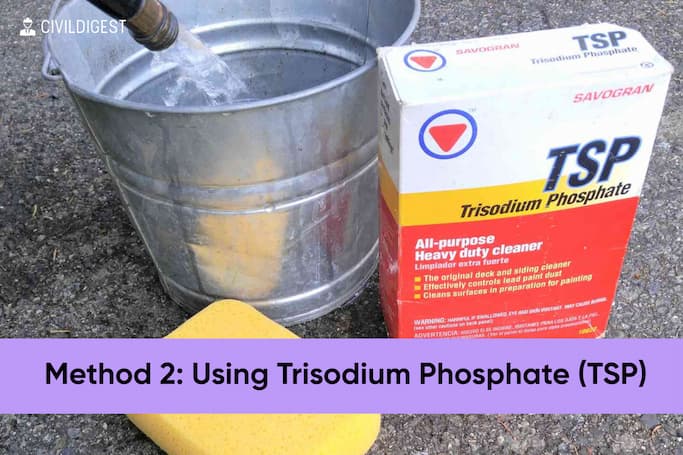
Materials Needed:
- Trisodium Phosphate (TSP)
- Water
- Scrub brush
- Rubber gloves
- Bucket
- Safety goggles
Step-by-Step Guide:
- Wear rubber gloves and safety goggles for protection.
- In a bucket, mix a solution of TSP and water as per the manufacturer’s instructions.
- Apply the solution to the paint stain, ensuring complete coverage.
- Let the solution sit on the stain for about 5-10 minutes, but avoid letting it dry.
- Scrub the stain vigorously using the scrub brush.
- Rinse the area thoroughly with clean water.
Pros:
- Effective for more stubborn or older stains.
- Can clean larger areas efficiently.
- Versatile cleaner, useful for various other cleaning tasks.
Cons:
- Potentially hazardous; requires safety precautions during use.
- Can be harmful to plants or grass if not rinsed properly.
- Not as eco-friendly as some other methods.
Why this method?
Trisodium Phosphate (TSP) is a powerful cleaner that can effectively tackle tough spray paint stains on concrete. Its strong cleaning capabilities make it a go-to choice for professionals and DIY enthusiasts when dealing with aged or thick paint residues. While it’s a bit more aggressive than the soap and water method, it’s often a necessary step for those challenging stains that refuse to budge with milder treatments. However, due care must be taken while using TSP due to its potential hazards, making it essential to follow safety guidelines diligently.
Method 3: Using Power Washer

Materials Needed:
- Power washer (with adjustable pressure settings)
- Water source
- Protective eyewear
- Ear protection
Step-by-Step Guide:
- Wear protective eyewear and ear protection.
- Connect the power washer to a water source.
- Start with a lower pressure setting to avoid potential damage.
- Aim the nozzle at the stain, keeping it at a consistent distance from the surface.
- Engage the trigger and move in a consistent back-and-forth motion over the stain.
- Gradually increase the pressure if the stain is not lifting. Be cautious of the power to avoid eroding the concrete.
- Once the stain is removed, rinse the area with a regular hose to clear any residue.
Pros:
- Efficient and fast for larger areas.
- No need for chemicals.
- Effective for removing multiple layers or larger splatters of paint.
Cons:
- Can be more abrasive; potential to damage the concrete if not used correctly.
- Might not be available for all homeowners.
- Can be noisy.
Why this method?
A power washer is an excellent tool for removing spray paint from concrete, especially over more expansive areas or where the paint is spread unevenly. The sheer force of the water can lift the paint off without the need for chemicals, making it an eco-friendly option. It’s particularly effective for those who want to avoid chemical methods or when dealing with a larger affected area. However, its effectiveness comes with the need for caution. Inexpert use can lead to pitting or erosion of the concrete surface. Always start with lower pressure settings and increase gradually, ensuring the concrete isn’t damaged in the process.
Method 4: Using Paint Stripper or Solvents
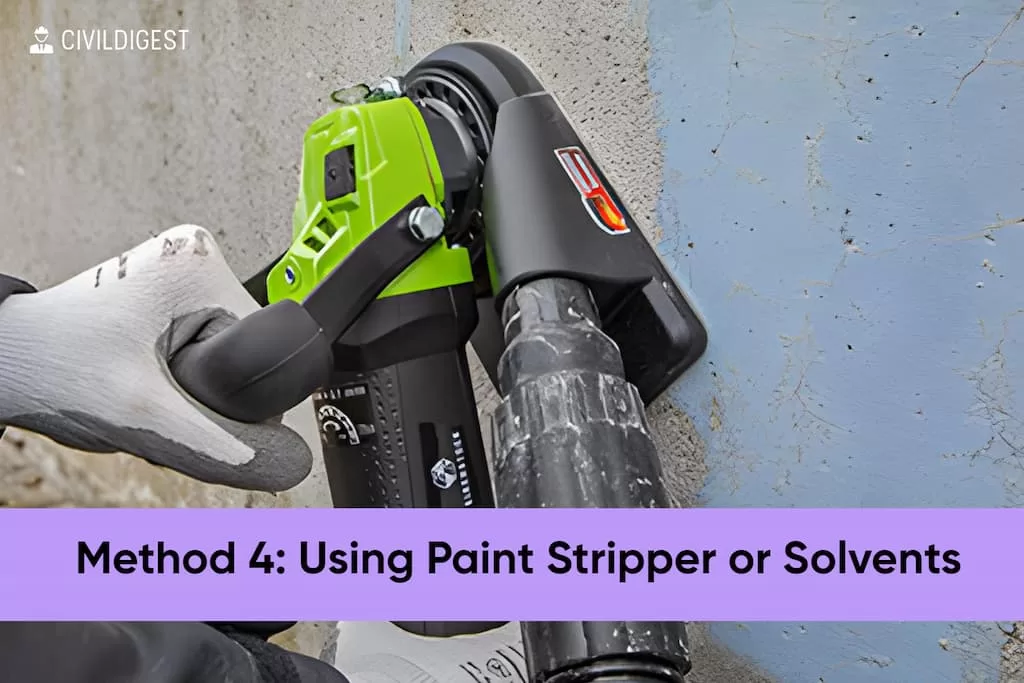
Materials Needed:
- Commercial paint stripper or solvent (specifically designed for concrete)
- Scrub brush
- Rubber gloves
- Safety goggles
- Bucket or container
- Water for rinsing
Step-by-Step Guide:
- Put on rubber gloves and safety goggles to protect your skin and eyes.
- In a well-ventilated area, apply the paint stripper or solvent to the spray paint stain following the manufacturer’s instructions. Often, this involves pouring or brushing it directly onto the stain.
- Allow the product to sit on the stain for the recommended time, usually 5-15 minutes. Some stubborn stains might require longer.
- Using a scrub brush, scrub the treated area vigorously.
- Rinse the concrete thoroughly with clean water to remove all residues of the paint stripper or solvent.
- If any stain remains, you can repeat the process.
Pros:
- Highly effective for stubborn stains.
- Works quickly compared to milder solutions.
- Suitable for multiple paint layers or aged stains.
Cons:
- Chemical solvents can be harsh on the environment.
- Requires proper safety precautions.
- Risk of chemical burns or eye irritation if not used correctly.
Why this method?
Paint strippers and solvents are designed to break down the chemical structure of paint, making them particularly effective for stubborn or old paint stains. They work more aggressively than milder solutions, ensuring a higher success rate in removing tough stains. This method is especially beneficial when dealing with paints that resist water-based cleaning methods or if the paint has penetrated deeper into the concrete’s porous surface.
However, the chemical nature of paint strippers demands responsible usage. Proper safety gear, adequate ventilation, and strict adherence to the manufacturer’s guidelines are imperative. This method, while effective, should be approached with care and consideration for both user safety and environmental impact.
Method 5: Grinding
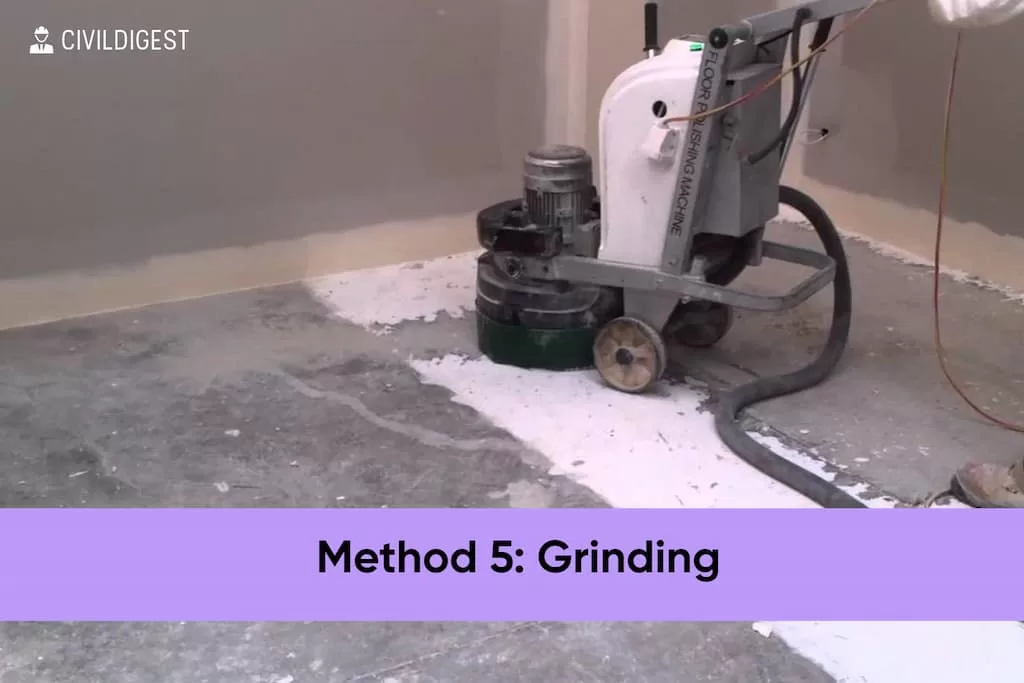
Materials Needed:
- Concrete or angle grinder
- The diamond grinding wheel or abrasive pad
- Safety goggles
- Dust mask or respirator
- Ear protection
- Protective gloves
Step-by-Step Guide:
- Equip yourself with safety goggles, a dust mask or respirator, ear protection, and gloves.
- Attach the diamond grinding wheel or abrasive pad to the grinder.
- Start the grinder, ensuring you’re familiar with its operations.
- Hold the grinder at a slight angle and begin grinding the paint off the concrete using steady back-and-forth motions.
- Apply even pressure but avoid pressing too hard to prevent gouging the concrete.
- Continuously check your progress, making sure not to grind too deeply into the concrete.
- Once the paint is removed, clean the area with water to remove any residual dust or particles.
Pros:
- Effective for deeper and stubborn stains.
- Removes not just the paint but also any superficial damage or discolorations on the concrete.
- Provides a clean, even finish.
Cons:
- Requires specialized equipment.
- Can be abrasive; and the risk of damaging the concrete if not done carefully.
- Creates a lot of dust.
- Might be overkill for smaller or fresher stains.
Why this method?
Grinding is an intensive method best suited for situations where other techniques might not have worked or when dealing with thick layers of paint. The abrasive action of the grinder ensures that the paint is removed down to the concrete’s surface. This method is also valuable for those looking to refurbish or refresh their concrete surface, as grinding can even out imperfections and leave a smooth finish.
However, it’s crucial to operate the grinder with care. Inexpert use can lead to permanent damage to the concrete, making it essential to approach this method with knowledge and precision. This method might not be the first choice for many due to the equipment and expertise required, but it remains a solid option for those challenging paint removal tasks.
Method 6: Using Graffiti Remover
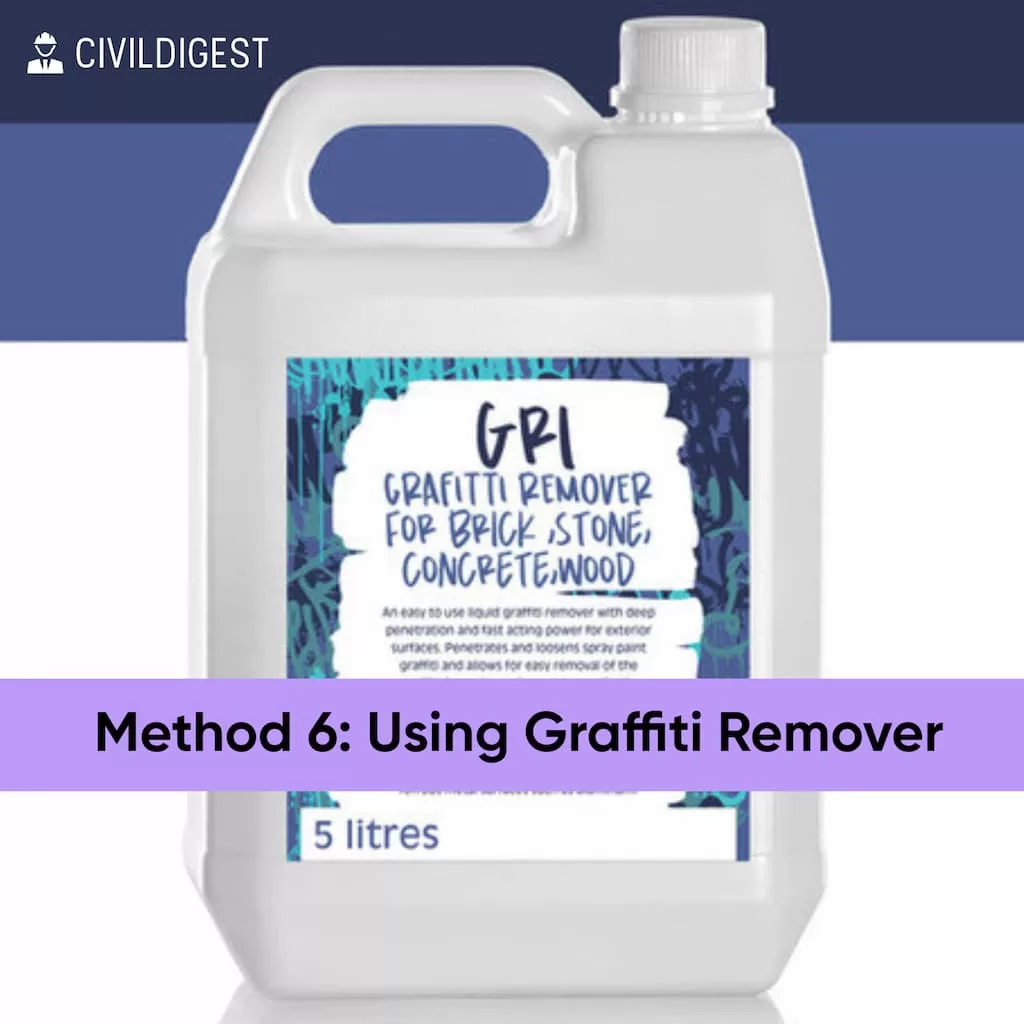
Materials Needed:
- Commercial graffiti remover
- Scrub brush or scouring pad
- Rubber gloves
- Safety goggles
- Cloth or rag
- Water for rinsing
Step-by-Step Guide:
- Wear rubber gloves and safety goggles to protect against any splashes or irritations.
- Shake or stir the graffiti remover before use, if instructed by the manufacturer.
- Apply the graffiti remover to the spray paint stain, ensuring generous coverage. Use a cloth or directly pour based on the product’s consistency.
- Allow the product to sit on the stain for the recommended duration, typically between 5-30 minutes, depending on the product and the stain’s age.
- Use a scrub brush or scouring pad to scrub the treated area, working in circular motions for maximum effectiveness.
- Rinse the area thoroughly with water to clear away the graffiti remover and lifted paint.
- If some paint remains, you can repeat the process.
Pros:
- Specifically designed to tackle spray paint, making it highly effective.
- Easy to apply with minimal preparation.
- Suitable for both fresh and older stains.
Cons:
- Some graffiti removers may contain harsh chemicals.
- Requires safety precautions during use.
- Can be more expensive than DIY methods or general-purpose cleaners.
Why this method?
Graffiti removers are specially formulated to dissolve and lift spray paints, making them a top choice for many facing unwanted paint marks on their concrete surfaces. Their targeted action often means quicker and more effective results than more general cleaning methods or DIY solutions. For those facing persistent or challenging paint stains, a graffiti remover can be a game-changer. However, it’s essential to choose a product wisely, taking into account its environmental impact and chemical composition. Some graffiti removers can be harsh, so always prioritize safety, use in a well-ventilated area, and follow manufacturer instructions meticulously.
Method 7: Using Vinegar
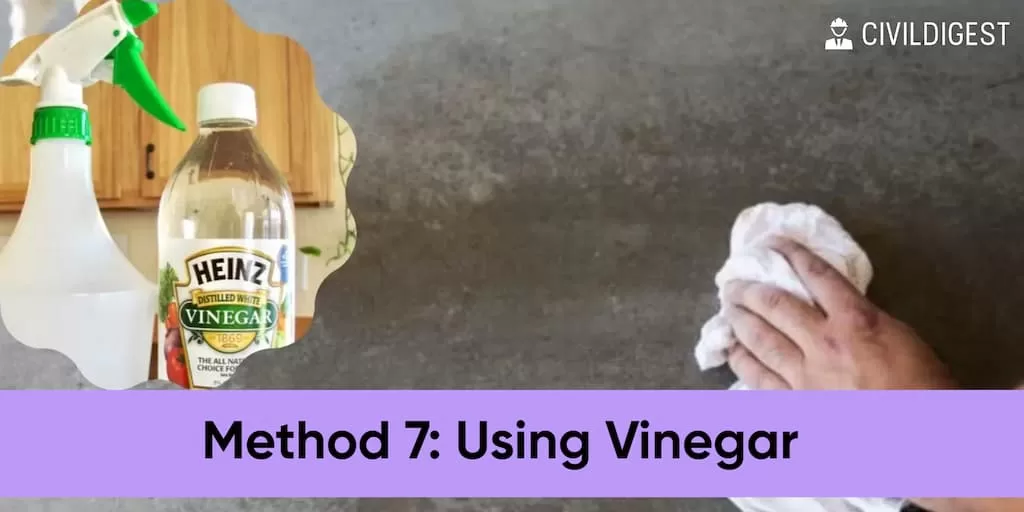
Materials Needed:
- White distilled vinegar
- Scrub brush or scouring pad
- Rubber gloves
- Bucket or container
- Water for rinsing
- Cloth or sponge
Step-by-Step Guide:
- Use rubber gloves to protect your hands.
- Pour white distilled vinegar into a bucket or container.
- Saturate a cloth or sponge with the vinegar and apply it generously to the spray paint stain.
- Allow the vinegar to sit on the stain for about 20-30 minutes to break down the paint.
- Using the scrub brush or scouring pad, scrub the treated area in a circular motion.
- Rinse the area with clean water to remove vinegar residues and any loosened paint.
- If the stain persists, you can repeat the process or leave the vinegar on for a more extended period.
Pros:
- Eco-friendly and non-toxic.
- Easily accessible and affordable.
- Safe for most surfaces, including concrete.
Cons:
- May require multiple applications for tougher stains.
- Might not be as effective as specialized chemical removers.
- The smell of vinegar can be strong during the process.
Why this method?
Vinegar, with its natural acidic properties, serves as a versatile cleaning agent for various household stains, including spray paint on concrete. For those seeking an environmentally friendly, readily available, and affordable solution, vinegar can be a great choice. It’s particularly suitable for those wary of using harsh chemicals or those without access to specialized graffiti removers. While vinegar might require patience and potentially multiple applications, its safety profile and minimal environmental impact make it a preferred method for many. When considering the overall health of your surroundings and the desire to use natural products, vinegar stands out as a tried-and-true method.
Method 8: Using Acetone
Materials Needed:
- Pure acetone or nail polish remover containing acetone
- Scrub brush or scouring pad
- Rubber gloves
- Safety goggles
- Cloth or rag
- Water for rinsing
Step-by-Step Guide:
- Before starting, ensure you’re in a well-ventilated area to avoid inhaling acetone fumes.
- Wear rubber gloves and safety goggles for protection from splashes and potential irritants.
- Moisten a cloth or rag with pure acetone.
- Dab or rub the cloth onto the spray paint stain, ensuring the paint is fully covered with acetone.
- Allow the acetone to work on the stain for a few minutes.
- With a scrub brush or scouring pad, scrub the area in a circular motion to lift the paint off the concrete.
- Rinse the treated area with clean water to remove any acetone residues.
- If remnants of the paint stain persist, repeat the process as necessary.
Pros:
- Quick action due to the potent solvent properties of acetone.
- Easily available.
- Effective for a variety of paint types.
Cons:
- Highly flammable; caution is required during use.
- Potentially harmful fumes; good ventilation is essential.
- Can dry out or harm skin on direct contact.
Why this method?
Acetone is a powerful solvent that can break down a wide range of paints, making it particularly effective for removing spray paint from concrete. For those who want a method that works fast and doesn’t require long waiting times, acetone might be the way to go. However, safety is paramount when using acetone. The fumes can be harmful if inhaled, and the liquid is highly flammable. Moreover, it’s crucial to avoid skin contact as it can cause dryness or irritation. In scenarios where quick action and effectiveness are prioritized, acetone shines, but always with careful handling and safety measures in place.
Method 9: Using Muriatic Acid
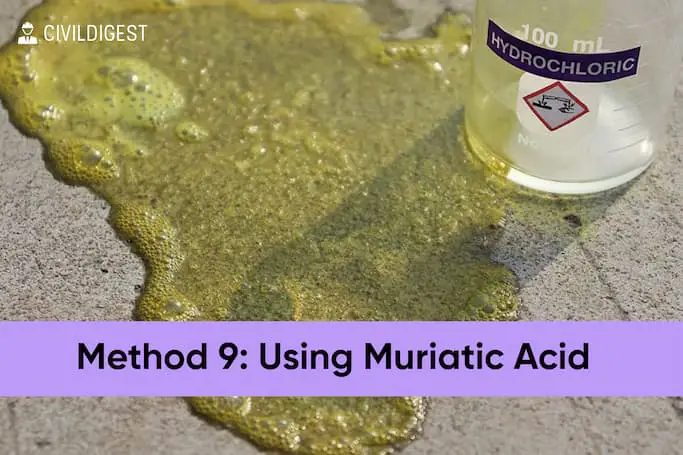
Materials Needed:
- Muriatic acid (also known as hydrochloric acid)
- Large bucket or container
- Water
- Rubber gloves
- Safety goggles
- Protective clothing
- Neutralizing agent (baking soda or garden lime)
- Scrub brush or scouring pad
Step-by-Step Guide:
- Prioritize safety by wearing rubber gloves, safety goggles, and protective clothing. Ensure you’re working in a well-ventilated outdoor space.
- In a bucket, create a diluted solution by mixing one part muriatic acid with ten parts water. Always add acid to water, not the other way around, to prevent splashing.
- Gently pour the diluted solution onto the spray paint stain.
- Allow the solution to sit on the stain for about 5-10 minutes. Do not let it dry on the surface.
- Scrub the treated area with a scrub brush or scouring pad, working the acid into the stain.
- Thoroughly rinse the area with water to ensure all acid residues are washed away.
- Neutralize the treated area by sprinkling baking soda or garden lime. This step neutralizes any remaining acid residues.
- Once again, rinse the area to wash away the neutralizing agent.
Pros:
- Powerful and effective, especially on stubborn or old stains.
- Can also help to clean and brighten the overall appearance of the concrete.
Cons:
- Highly corrosive and can pose health risks if not handled correctly.
- Can potentially damage the concrete if left on for too long.
- Not environmentally friendly.
Why this method?
Muriatic acid is a potent agent known for its ability to break down and remove tough stains, including spray paint, from concrete surfaces. It’s especially beneficial when other methods fall short or when dealing with particularly resistant or old paint stains. However, it’s essential to approach this method with utmost caution due to the inherent risks associated with handling such a corrosive substance. Proper dilution, careful application, and thorough rinsing are vital to prevent damage to the concrete and ensure safety. This method isn’t the first choice for everyone because of its harshness and environmental concerns, but when faced with challenging paint removal tasks, muriatic acid can be a game-changer if used responsibly.
Method 10: Using WD40
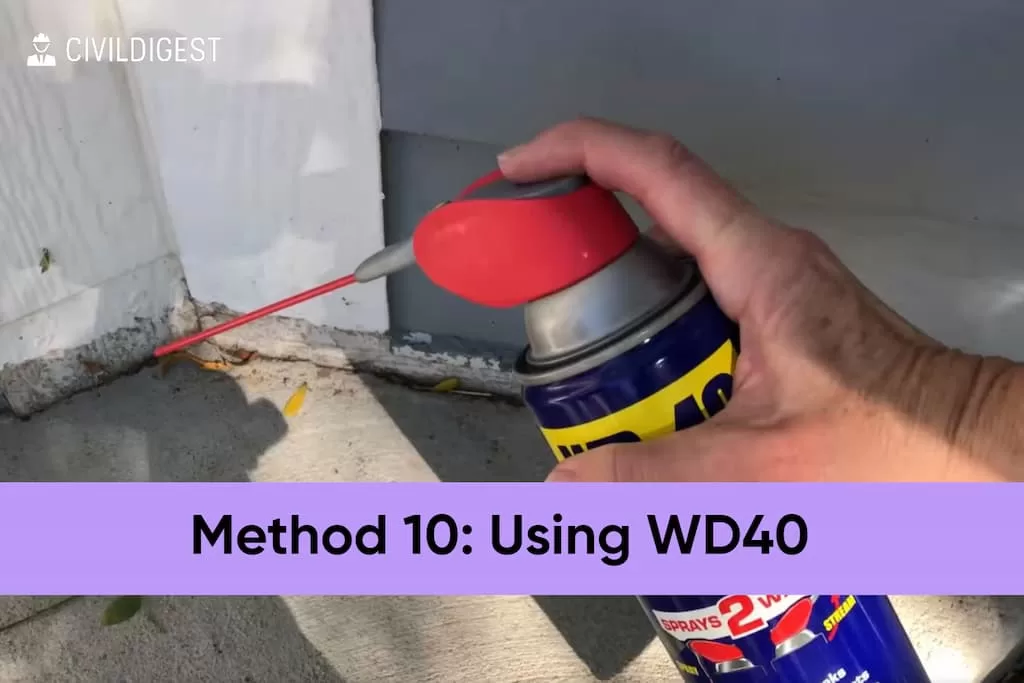
Materials Needed:
- WD40
- Cloth or rag
- Scrub brush or scouring pad
- Rubber gloves
- Safety goggles
- Water for rinsing
Step-by-Step Guide:
- Wear rubber gloves and safety goggles to ensure protection.
- Generously spray the affected area with WD40.
- Allow the WD40 to sit on the spray paint stain for about 20-30 minutes. This gives it time to penetrate and soften the paint.
- Using a cloth or rag, wipe away the loosened paint. For tougher spots, scrub with a brush or scouring pad.
- Rinse the treated area with clean water to remove WD40 residues and any remaining paint.
- If some paint remains, repeat the process as needed.
Pros:
- Non-abrasive and gentle on the concrete.
- Easily available in most households or hardware stores.
- Multi-purpose product that can be used for various tasks around the home.
Cons:
- Might not be as effective on older or tougher stains.
- Could require multiple applications for complete removal.
- Some might be concerned about the environmental impact.
Why this method?
WD40 is a versatile lubricating spray that many people have on hand in their homes or garages. Its ability to penetrate and break down various substances makes it useful for removing spray paint or remove tire marks from concrete. It’s a great go-to method, especially if you’re looking for a less abrasive approach that won’t harm the concrete surface.
While it might not pack the punch of more aggressive chemicals or solvents, its ease of use and safety profile make it a popular choice for many. For those who are apprehensive about diving into the use of harsh chemicals or just want to try a household item first, reaching for the WD40 can be an effective initial step in paint removal.
Method 11: Using Lacquer Thinner
Materials Needed:
- Lacquer thinner
- Cloth or rag
- Scrub brush or scouring pad
- Rubber gloves
- Safety goggles
- Water for rinsing
Step-by-Step Guide:
- Safety first: Wear rubber gloves and safety goggles. Ensure the working area is well-ventilated to avoid inhaling fumes.
- Moisten a cloth or rag with lacquer thinner.
- Apply the moistened cloth directly to the spray paint stain, ensuring thorough coverage.
- Let the lacquer thinner sit on the stain for several minutes, allowing it time to break down the paint.
- Use a scrub brush or scouring pad to scrub the affected area, lifting the paint off the concrete.
- Rinse the area with water to wash away any lacquer-thinner residue and loosened paint.
- If any paint remains, you can repeat the process.
Pros:
- Highly effective in dissolving a variety of paint types.
- Quick action due to its potent solvent properties.
- Leaves a clean finish on the concrete.
Cons:
- Potentially harmful and strong fumes; always work in a well-ventilated space.
- Flammable and should be used with caution.
- Can be harsh on the skin; always wear protective gear.
Why this method?
Lacquer thinner is a powerful solvent renowned for its capability to dissolve paints and finishes. It’s a prime choice for those looking to tackle tough or older spray paint stains on concrete. Its potency ensures that the paint is broken down effectively, making it easier to scrub away. However, with its power comes a set of precautions. Due to its strong fumes and potential flammability, it’s vital to handle lacquer thinner with care and in well-ventilated conditions. For those who have tried gentler methods with limited success or are dealing with particularly stubborn stains, lacquer thinner offers a more aggressive solution. But remember, safety should always be paramount when working with such potent solvents.
Protecting and Cleaning the Concrete Surface
Once you’ve succeeded in the arduous process of removing spray paint from the concrete surface, it’s equally critical to ensure the right measures to cleanse and safeguard the concrete surface.
Cleaning the Concrete Surface after Spray Paint Removal
After you have removed the spray paint, the concrete might still have paint thinners or solvents, which should be cleaned to restore the concrete to its natural state.
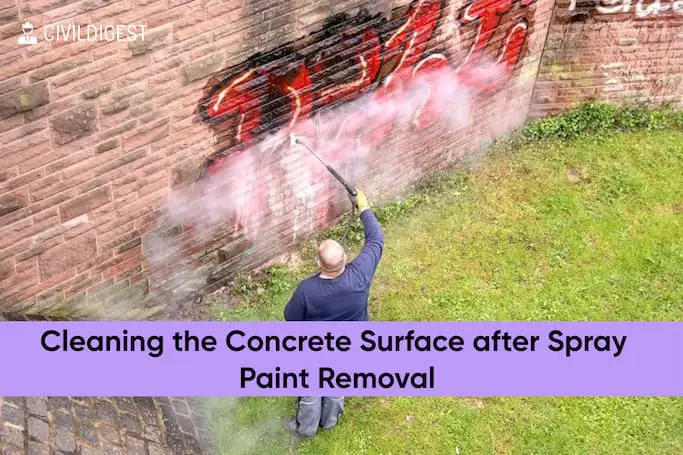
Here are the simple steps to be followed:
- Thoroughly sweep the area, ensuring all the loose debris is removed.
- Fill a bucket with warm water and add a mild detergent. Stir until it forms soapy water.
- Soak the brush in the soapy water and then start scrubbing the entire surface.
- Rinsing the area with a water hose will help you wash away soap and detergent.
- Allow the surface to dry naturally.
Tips for Protecting Concrete Surfaces
To prevent future incidents that may stain the concrete, and to retain its aesthetic and strength, here are some useful tips:
- Regularly clean the concrete surface to avoid dust and dirt buildup.
- Apply a quality concrete sealer to protect the surface from stains and damage.
- Avoid painting or spraying close to the concrete surface.
- Ensure the concrete is cured properly before applying any paints or coatings.
- Use protective sheets or covers while working in nearby areas.
Safety Precautions
While the process of removing spray paint from concrete is crucial, putting safety measures in place to protect yourself and your immediate environment is of paramount importance. The use of potent chemicals and machinery also brings the risk of accidents, so adequate precautionary actions need to be taken before you begin with the process.
Wear Protective Gear
Given the potential hazards of working with chemicals and abrasive technologies, wearing protective gear is mandatory.
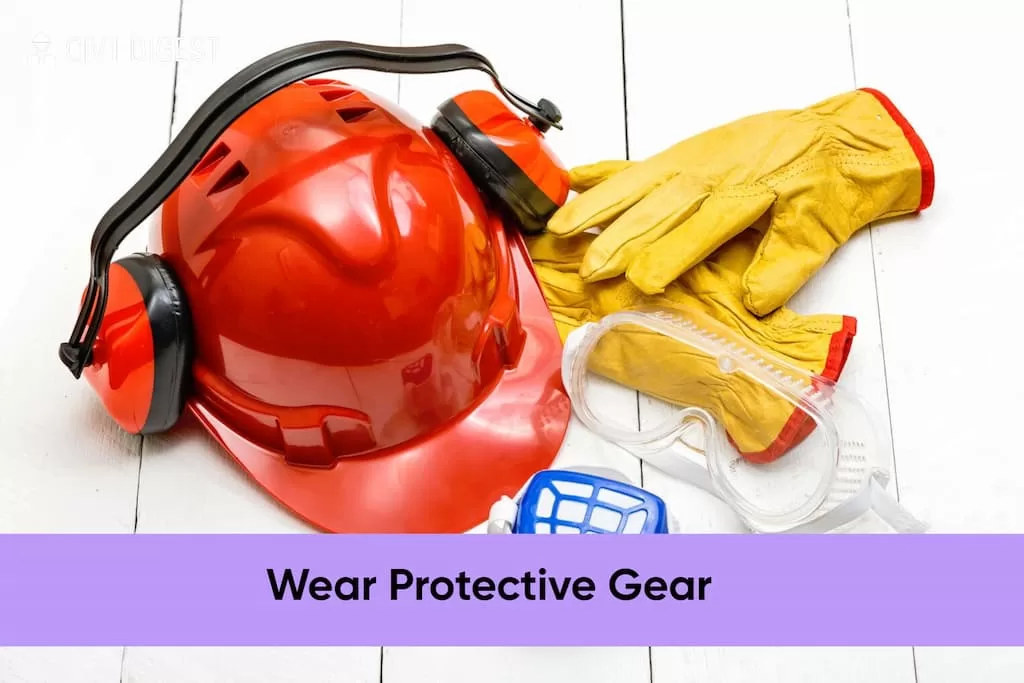
Here are the kinds of gear you should consider:
- Protective gloves: Wear chemical-resistant gloves to protect your hands from harmful chemicals.
- Protective eyewear: This protects your eyes from any chemical splashes or debris during the cleaning process.
- Respiratory mask: This is important, especially when you are dealing with chemicals that may produce harsh fumes.
Proper Ventilation
Proper ventilation is a pivotal safety measure, especially when working indoors or in areas with limited air circulation. Some paint removers or cleaning solutions may release toxic fumes, which can be hazardous if inhaled.
Here are some guidelines to ensure proper ventilation:
- Always keep doors and windows open while using chemicals.
- Use fans to circulate the air in indoor spaces.
- Always follow the manufacturer’s safety instructions when using chemicals.
Frequently Asked Questions
The following are some frequently asked questions regarding the removal of spray paint from concrete.
Will vinegar remove spray paint from concrete?
Yes, vinegar can help in removing spray paint from concrete. As a household item, vinegar is acidic and can act as a mild solvent, capable of breaking down some types of paints and stains.
Will baking soda remove paint from concrete?
Yes, baking soda is another household item that can be used to remove paint from concrete. Baking soda is a light abrasive and can scrape away layers of paint without damaging the concrete.
Conclusion
Getting rid of unwanted spray paint from a concrete surface demands careful planning, the use of the right techniques, and patience, but with the right knowledge, it is a manageable task. In this comprehensive guide, we’ve covered a variety of methods, from more accessible home approaches, like using vinegar and baking soda, to more potent strategies involving professional tools and chemicals.
No matter the technique, safety should be your priority, ensuring the use of protective gear and maintaining proper ventilation throughout the process. Moreover, proper post-paint removal cleaning and protection of the concrete surface ensures longevity and the preservation of its aesthetics.
Remember that paint removal efficacy may vary depending on the type and age of paint and that a method that works on one surface may not necessarily work on another. Lastly, the process might take time and multiple attempts, so patience is key. Conclusively, while removing paint from concrete can seem daunting, it’s merely about understanding the methods and taking a methodical, step-by-step approach to restore your concrete surface to its pristine condition.












